Chazot's Chat
If you want to know about a horse's life just look into his eyes.
|
|
Greetings!
We have had a traumatic past few days, read A night of terror. Chazot is alive and well and we hope by Monday our boy will be home. A very special thank you to the wonderful team of Vets and staff at UGA! !
Much to read in this issue enjoy and we would love to hear back from you.
Sincerely,
Editor Helyn Cornille
Science Of Motion |
|
Educate Your Eye
Weekly Series
Each week new images with a question and answer. Two this week.
Question- Chazot looks beautiful in both these pictures, but you said there was a problem with his position. Can you explain what is wrong and how to fix it?
-Question by Helyn
Jean Luc's response:
Well, the problem starts at the first picture. I am asking him to bend the thoracic spine to the left. Chazot is not then optimally ready for such bending. He starts to bend left but does not really bend the thoracic spine. Instead, he is contracting the middle of the neck on the left side. The neck contraction is only the visible part of the iceberg. It is due to the fact that he is not properly coordinating lateral bending and transversal rotation. The neck contraction is barely apparent and the picture still looks good.
READ ON
|
|
Chazot Thoughts XI
(Sorry to burst your bubble but that is not piaff)
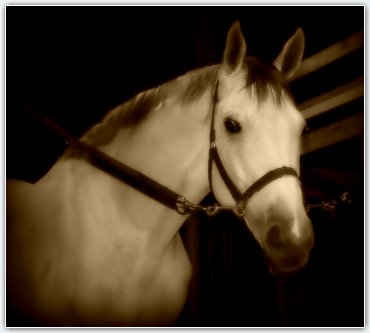
Often at the end of the day, Helyn and he bring out two chairs and drinks and sit between Manchester's pasture and my turn out and watch us. This is a time of peace where we all enjoy each other's company. Even the kissing machine is resting. Bretelle is a boxer with a tongue longer than his body. He is the gentlest dog on earth but he always tries to kiss us. You cannot imagine the length of his tongue. I lift my nose a few inches thinking that I am out of reach and within the next second I have half of his tongue deep inside my nostril.
Sometimes, Helyn and he are engaged in a long conversation. Other times they stay silent listening and watching. Yesterday, Helyn brought a photo that she took earlier during our training session. She walked toward me showing the picture. I remember the trot departure. I felt I was in good balance and succeeded in a departure quite collected. I noticed the position of my legs on the picture thinking that it almost looks like piaff. This is when he thinks, Sorry to burst your bubble but that is not piaff.
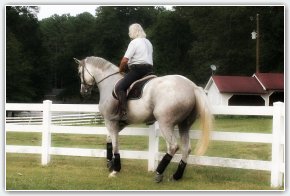
I was shocked. I am supposed to be the one who can read his thoughts. He is not supposed to know mine. I knew that this was not piaff. I was simply playing the game of many riders who are using pictures, which look like piaff to burst their ego. Mostly to verify if he really can read my thoughts I pushed the issue insisting that may be it was not a true piaff but it was close.He scared me, as he thought, "Not even close. The picture was taken at a good time and your legs may appear to be doing piaff but the synchronization of your back and legs is not correct. Your supporting hind leg is on the pushing phase. If you were at the piaff, it would be in the braking phase. I said to Manchester, he really knows what I think. Manchester disagreed. I don't think so. He does not even believe in animal communicators. Your former owner was a so-called animal communicator and she never had any clue of your emotions, suffering and thinking. Let me tell you what I think is happening. My belief is that when his brain is on a subject, he explores further and further. I think that he is following his own thoughts and it just happens that his thoughts appear to answer your questions. In fact; I see there the potential for some juicy exchanges. Ask him about subjects unrelated to horses.
READ ON
|
|
The Cost Of Lameness
The Value of Knowledge
The cost of lameness is much greater than the vet bill, the months of wasted training and show expenses. Even if in public one may blame the farrier, the footing, or the saddle, the cost of lameness is the sad taste of failure. The cost of lameness is also the horse's suffering and in most instances a forever drop of the horse's value. Bow tendon for example can be superficially repaired but the tendons fibers are irreversibly disturbed and the tendon's structure has for ever lost elasticity and strength.
Competitions are putting the horse's physique at risk of injuries and injuries are often regarded as the fatal cost of athletic achievements. Through better understanding of the stresses that the performance induces on the horse's physique, advanced research studies offer the capacity to prepare efficiently the horse's body for the effort and hens, to considerably reduce the risk of injury.
James Rooney wrote, "The gait abnormality created by a specific lesion is the gait abnormality that causes the lesion." The capacity to distinguish and correct the gait abnormality, which over a period of time may create injuries, is invaluable. This allows the horse to perform at the best of his potential while remaining sound. The greatest cost of injury is that in most instances, the damages could have been prevented. The technique used to rehabilitate desperate cases is the technique which, if used on the first place would have prevented injuries.
Through our DVDs, Books, pdf Files, Immersion Programs and Clinics we offer much more than the same old think rephrased au gout du jour, (following the fashion). Each word is the product of advanced scientific findings and an extensive experience focusing on the practical application of pertinent discoveries. You can read anyone of our publications ten times and you will still find information, thoughts and suggestions that you did not previously noticed.
In 1990, Nancy Deuel identified the recipe for superior flying change. Not one of the riding techniques commonly emphasized permit to apply Nancy Deuel's findings. "Preceding a lead change, the higher-scoring horses increased their contact duration of the hind limbs and decreased the length of step and time between forelimb impacts to prepare to execute the lead change in the succeeding airborne phase." (N. R. Deuel, PhD: J. Park, PhD, 1990) You will find the practical application of Deuel's findings in our lines. Not under the form of a single formula but rather through many insights which gradually guide your mind and your horse mind toward the body coordination allowing great performances and the propensity to preserve the horse's soundness.
DVD's, PDF's & Books
Give the gift of value, soundness to our equine partners.
|
Response to the waspish ghosts of theological thinking. VI
As long as they are alive, horses adapt to the rider's movements and compensate for the incongruities of the training techniques. After death, as they became specimens into the necropsy room, the naked true is there, exposed on the table. A research, which demanded isolation of the whole vertebral column, was executed on three specimens. The three vertebral columns remained crooked even after all muscles and ribs have been removed. Only the vertebrae and the ligaments were left and the spine maintained one side bending, or inverted rotation or the combination of both.
(The white line underlines the crookedness, left lateral bending and inverted rotation)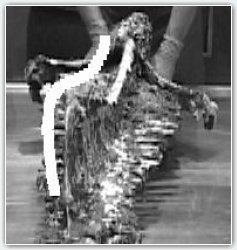
One can easily imagine that when he was alive, this horse had great difficulty bending to the right. The right lead canter was likely difficult and the horse might have been punished for is behavior. He does not want to bend on the right circle. He does not want to give the right lead canter. In fact, on the necropsy table, it was very difficult to bend the spine to the right. The specimen was so deeply crooked that even when all the muscles were removed the spine remained crooked.
The purpose of the study was not to verify this phenomenon. In fact the finding was a surprise. The question is; what causes such crookedness. The response is straight forward; the combination of natural predisposition and bad training. At the walk as well as at the trot, the thoracolumbar spine bends alternatively to the right and to the left in coordination with the limbs action. Lateral bending is always coupled with a movement of transversal rotation and therefore any imbalance between right and left side of the back muscles will alter the symmetry between one lateral bending over the other and/or one rotation over the other. Since, like a human, a horse is never perfectly symmetrical, an inherent muscle imbalance will became worse and worse with the presence of a rider on the horse's back and never the less with the demand of athletic performances.
A horse is living in the moment and therefore a horse does not work or correct naturally a muscle imbalance. Instead, the horse develops compromises to protect it. The rider is responsible for a sound analysis of the horse's locomotor patterns and the conception and the execution of a gymnastic program recreating symmetry of the back muscles.
Lateral bending may be associated with a correct rotation but also can be coupled with an inverted rotation. The specimen presented here obviously combined left lateral bending and inverted rotation. Such combination induces abnormal stresses on the vertebral column and consequently on the limbs action. In fact in almost every case of navicular syndrome that we have rehabilitated, inverted rotation was the culprit.
The question is what causes inverted rotation. Once again, the response is straight forward, the combination of natural muscles imbalance aggravated by bad training. The drawing illustrates one type of bad training but in fact all training techniques promoting lateral bending of the horse's thoracolumbar spine through hands actions that are bending the neck laterally are creating inverted rotation.
Our ancestors believed that the horse's vertebral column bended laterally from the tail to the neck. Better knowledge demonstrated that in fact lateral bending was mostly occurring between the 9th and 14th thoracic vertebrae, which are exactly between the rider's thighs. There is also very little lateral bending in the lumbar region, between the first and the fourth lumbar vertebrae.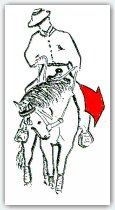 It belongs to the rider's back, pelvis and thighs to bend the horse's thoracic spine and definitively not to the rider's hands. It belongs to the rider's back, pelvis and thighs to bend the horse's thoracic spine and definitively not to the rider's hands.
Theologians of the Dark Age pretend otherwise wishing that more people come to them for learning. Thanks for the horses, even if the dark side of the internet is to allow the ghosts to write on and on about how great they are and how bad other people are, the internet also allows introduction and discussion of pertinent discoveries. As say Eleanor Roosevelt, "Great minds discuss ideas, average minds discuss events, small minds discuss people."
Jean Luc Cornille
Read on website
|
|
A New Approach to Lameness
Part 2
Image by ShortHorse Studios
Heather K McManamy
"Movements are generated by dedicated networks of nerve cells that contain the information that is necessary to activate different motor neurons in the appropriate sequence and intensity to generate motor patterns". (1) These networks are referred to as Central Pattern Generators (CPGs). Locomotors CPGs are inactive at rest. They are turned on when the horse is set in motion by signals from command centers. Unless the rider's equitation specifically coordinates the horse's physique to further the benefits of static therapies once the horse is set in motion, very little of these therapies will help the horse through gaits and performances.
"Since the growth of knowledge is the core of progress, the history of science ought to be the core of general history. Yet the main problems of life cannot be solved by men of science alone, or by artists and humanists: we need the cooperation of them all." ( George Sarton) As well, neither the veterinarian, the farrier, or the therapist alone can solve the horse's problem. A cooperation of them all, including the rider and the trainer is necessary. If after successful treatment and/or shoeing, the equitation that failed to efficiently prepare the horse's physique for the athletic demand of the performance is applied again, the same or parallel injury is likely to reoccur.
The greatest discovery made by the practical application of advanced research studies is that the old adage, back soreness is only a compensation for hock pain or other musculoskeletal disorders, is inaccurate. In most instances back muscle imbalance or other vertebral column dysfunctions are the root cause of limbs kinematics abnormalities and consequent injuries. The second greatest discovery made by the practical application of advanced research studies is that the consensus ruling most equestrian theories as well as training techniques,the horse's lower line, (abdominal and limbs muscles), is flexing the horse's upper line, (the back), is inaccurate too.
In the necropsy room, we sectioned vertically a specimen at the level of the second lumbar vertebra. 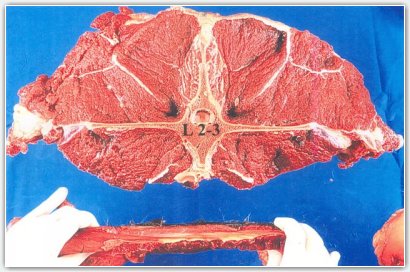
The picture shows the very large discrepancy between the mass and power of the back muscles, (upper half of the picture), by comparison to the size of the abdominal muscles, (lower half of the picture). Considering that in motion, abdominal muscles have to stabilize the gastro-intestinal track which is moving back and for like a piston, the thought that the abdominal muscles have the power to flex the mass of the back muscles is a leap of faith. Factual analysis suggests to the contrary that another and more powerful muscular system, the back muscles, is flexing the thoracolumbar spine.
READ ON
|
|
A Night of pure terror
"A champion is someone who gets up, even when he can't."
~ Jack Dempsey
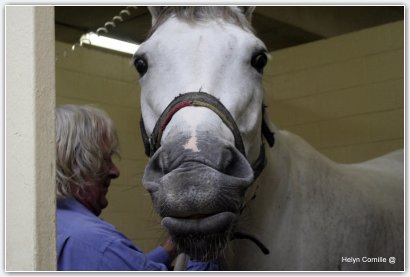
I am Manchester and I witnessed the whole night of plain terror. I know that Chazot will probably not remember. He was under so much pain that his brain was both in total panic and yet in survival mode. All started with a routine maintenance. The vet was here to float our teeth. As the vet often does, he gave us a sedative and we became somewhat unaware and sleepy. When I woke up, Chazot was not right. He told me that the vet also updated us about vaccines. I was surprise that both treatments were done the same day. Helyn wondered about the thought of giving vaccine after sedation but the vet insisted that there was no possibility of interference.
He was away giving a clinic in Florida and the vet reassured Helyn that it was no risk at all. The vaccines were not scheduled. This was only a day to have our teeth checked and taking care. Viewing our records, the vet insisted on giving us vaccine injections.
As the effects of the sedative were fading, I realized that Chazot was agitated showing discomfort in his whole body. He was acting colicky. Helyn observed the reaction, talked on the phone with he and they both decide to help Chazot with an injection of Banamine. The medication seems to work at first and Chazot was back with is usual complain about food, not enough. We only had a little bit of hay, which is normal procedure until the effects of sedation have totally disappeared.
Around midnight Chazot was pounding angrily breaking a sweat. I know that they have a video and audio system connecting our barn and their bedroom. I was hoping that Helyn would hear Chazot's agitation and effectively she did. She was there a few minutes later calling the vet. I had bad feeling when I heard through Helyn's phone that the vet was complaining that she was in bed.
Chazot was now experiencing excruciating pain. Helyn was walking him waiting for the vet but Chazot's brain was flipping back and for between awareness and he was walking following Helyn, and loss of connection where he was trying to throw himself violently onto the ground, whenever he was walking on the grass or on the driveway which is hard surface. Chazot is 1800 pounds. Helyn is tall but quite fine. I don't know how she convinced him to walk and not roll. He threw himself onto the ground a few times but was able at some moment to reconnect with her. She was talking to him, screaming at him when his brain was gone, gesticulating at him. She used all the energy she had to keep him going. This nightmare lasted one hour or more. Through brief instants, the pain was less intense and Chazot was waking not too reluctantly. Helyn was then on the phone with him describing the situation. Several times she had to interrupt the phone call because Chazot was going into another violent crisis.
I can imagine his wariness. He was 1000 miles away, giving a clinic and there is nothing he could do. I remember that two years ago, they had a comparable problem. Chazot was diagnosed of having colic and the violence of his reaction even after the vet had administrated drugs and sedatives directed everyone thought toward the possibility of impaction. However, the vital signs were not bad. There was a discrepancy between the violence of Chazot's reactions and a relatively reasonable heart bit and no temperature. I knew what the problem was but I could not tell them. It was in a corner of the property a growing plant that is poisonous for us. You could barely see it but Chazot found it. He tasted it, looked at me thinking, curious, and he tasted it a little more. This type of plant does not kill us but give us a serious stomach hake. I told him, You should not eat that, this will make you sick. I was new in the family and at this time I was a little jealous of his athletic abilities and a little annoyed by his arrogance, I turned away thinking, after all, it is your stomach. I felt so bad this evening when he was throwing himself onto the ground into violent convulsions. I learned then that Chazot was having ulcers and was in fact starting a treatment for his problem. I imagine that the poisoning effect of the plants was aggravating the ulcers. The vet asked tohe, Is your horse a Sissy? We both shake our head simultaneously. Chazot is in fact quite hard to pain. This reinforced the thoughts that Chazot was developing an impaction. They were making preparations to send him for eventual surgery. Both, the vet and he talked about the fact that the first thing that will be done at the hospital will be to put him under IV fluid. The vet was seeing signs of slight improvement and he was thinking that even if the symptoms aimed toward severe colic, the problem might not really be colic. The vet agreed to put Chazot under IV fluid. While the first bag of fluid was dripping into Chazot's veins, the vet went back to its hospital to bring back more bags of fluid.
|
|
Immersion 4
A Special Place for a Special Education
November 18th,19th & 20th
Providing the science behind riding and training techniques is the trademark of Jean Luc's teaching. Clinics are successful because Jean Luc teaches how to adapt riding skills and knowledge to the horse's peculiar needs. This distinguishes Jean Luc method from the usualsubmitting the horse to the system.
A program needed to be created to go one step further, allowing riders, trainers and therapists to fully comprehend how the practical application of most advanced equine research studies can further horses' performances and restore soundness. We created Immersion: a property, an atmosphere and a use of equipment allowing a full immersion into advanced scientific knowledge and the practical application of such knowledge. Between the training ring where the rider working the horse or the therapist working in hand, learns the feeling of proper body coordination, and the class room where one can visualize the vertebral columns and body parts with computer animations how the horse's physique effectively works, Immersion is the ultimate learning tool. Immersion I, II and III have already furthered participants' knowledge and propensity to apply new knowledge, both in hand and under the saddle. Along the years, we will continue this program exploring new subjects and returning sometimes to the most interesting topics. The next Immersion is scheduled Friday November 18, Saturday November 19 and Sunday November 20. On Sunday 20th, Dr. Betsy Uhl D.V.M., Ph.D. Dip ACVP, will be our guest speaker, sharing with us pertinent observations made in the necropsy room in relation to lateral bending and transversal rotations of the horse's vertebral column. Sunday's topic will be the shoulder in, which is described by his inventor as "a movement oblique and circular" (Francois Robichon de la Gueriniere) . Centuries later, Jean Marie Denoix demonstrated that lateral bending was always associated with a movement of transversal rotation. "In the cervical and thoracic vertebral column, rotation is always coupled with lateroflexion and vice versa." (1999). Betsy's talk will introduce the unique perspective of verifying through manipulations in the necropsy room the veracity of advanced theories. We plan to invite guest speakers into our Immersion Program as much as possible including prominent veterinarians, breeders, farriers, etc). The topic of Friday 18 will be the Science of Motion's Work in- Hand. Introduction for some, advanced study for others, the in-hand technique can be used as an education for riders and trainers, and as a therapy. This is, for the therapist, a unique opportunity to further their work by placing the horse in motion. Saturday 19 will be the day of study. Horses brought to the Science of Motion because conventional as well as alternative approaches could not identify the root cause of their problems. Consequently they failed to rehabilitate these horses, and they will be analyzed in great detail until a sound working hypothesis can be suggested, and a gymnastic program can be proposed. One day will be how to use the Science of Motion's Work in Hand in the rehabilitation of injured horses Another day will be about Cases Study. One, two or more horses will be analyzed for their lameness or lack of performance. Solutions will be proposed and experimented in the training ring and then explained in great details in the class room. As for Immersion I, II and III, lunch and humor will be provided. The third day will focus on a specific gymnastic exercise. The November Immersion will analyze in great details the Shoulder In. The move is frequently used for rehabilitation as well as performances. For instance, the gymnastic of the shoulder in is particularly efficient for horses jumping with the knees close from each other over the jump.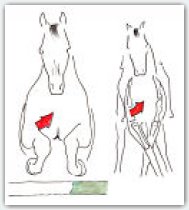 The presentation will include; 



For non-riders as well as rider, the Science of Motion's Work in Hand allows educating the horse to properly coordinate his vertebral column mechanism.
Contact us 941-539-6207 helyn@scienceofmotion.com
Register for Immersion 4 HERE
|
|